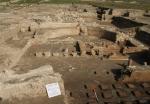Summary (English)
Contained within the limits of modern-day Skopje, Scupi was once an important Roman administrative center. For many decades now systematic archaeological investigations have been carried out on different sections of the 43ha area of the Roman city. The 2018 campaign was focused on the Thermae-Atrium Basilica complex east of the cardo maximus. It represents a complex of two different buildings from different periods – monumental baths from the early imperial Roman period and a Christian Basilica from the early 6th century partially overlying them. The plan of the thermae was typical for the time, with the usual sequence of rooms following the Roman tradition. It was relatively large, lavishly and luxuriously decorated structure with marble sculptures, marble votive plaques, fresco paintings and gold-foil mosaic decoration. In 2018 the easternmost parts of the complex were excavated, starting with the upper layers with the remains of a Late Antiquity residential complex contemporary to the basilica. After their removal, new rooms of the thermal complex were discovered, which corresponded to the previously established construction techniques and architectonic concept of the complex, but whose function will be additionally analyzed and interpreted. The investigations also included the NE portion of the external peripheral wall of the thermae complex, separating it from the cardo maximus, thus confirming the previous assumption that the thermae were spread over an entire block (insula) of the city.
Director
- Marina Onchevska Todorovska - Museum of the City of Skopje






![Download [PDF]](/excavation/skins/fasti/images/results/download_sml.png)

